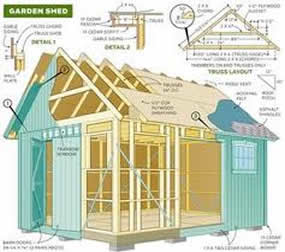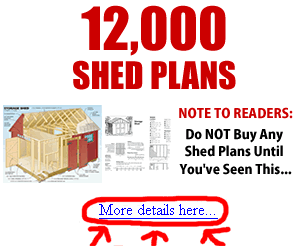
The Ultimate Guide to Building Your Own Shed in 2025: Costs, Permits, and Site Preparation

Building a shed is one of the most rewarding DIY projects you can tackle. Whether you need extra storage space, a workshop, or a garden retreat, a well-built shed adds both functionality and value to your property. This comprehensive guide walks you through everything you need to know before breaking ground.
Understanding Shed Building Costs
One of the first questions homeowners ask is: “How much will this cost?” The answer varies significantly based on size, materials, and whether you’re going DIY or hiring professionals.
DIY vs. Professional Installation
Building a shed yourself can save substantial money. A basic DIY shed typically costs between $1,500 and $8,000, depending on size and materials. For a standard 10×10 shed, expect to spend around $2,500 to $3,500 on materials if you’re doing the work yourself.
https://5c4a9xtft4r00r8oqbmfz6vj2l.hop.clickbank.net?cbpage=noexit

Professional installation, however, ranges from $5,000 to $15,000 for most projects. Custom or high-end sheds with premium features can exceed $20,000. The trade-off is expertise, time savings, and often a warranty on the work.
Cost Breakdown by Size
Here’s what you can expect to pay in 2025:
- Small sheds (8×10): $1,000 – $4,000
- Medium sheds (10×12): $2,500 – $8,000
- Large sheds (12×20): $4,000 – $15,000
- Extra-large sheds (20×20): $4,000 – $25,000+
Prefab shed kits typically cost $10 to $40 per square foot, while custom-built options run $30 to $150 per square foot.
Material Costs
Your choice of materials significantly impacts the final price:
- Wood: Most affordable and traditional, ranging from $15-$25 per square foot
- Metal: Durable and low-maintenance, $10-$30 per square foot
- Vinyl/Plastic: Weather-resistant, $20-$40 per square foot
- Concrete/Brick: Premium option, $40-$100+ per square foot

Navigating Shed Permits and Regulations
Before you start building, understanding permit requirements can save you from costly mistakes and legal headaches.
When Do You Need a Permit?
Permit requirements vary significantly by location, but general guidelines include:
Size thresholds: Most jurisdictions require permits for sheds larger than 100-200 square feet. Some areas allow structures up to 120 square feet without permits, while others are more restrictive.
Height restrictions: Single-story sheds under 12 feet in height often qualify for permit exemptions. Taller structures typically require approval.
Utilities: If you plan to add electricity, plumbing, or HVAC systems, you’ll need a permit regardless of shed size.
Foundation type: Permanent foundations (concrete slabs) usually require permits, even for smaller structures.
Regional Variations
Permit rules differ drastically by state and county:
- Florida: Sheds 100 square feet or larger typically require permits
- Oregon: Permits needed for structures over 200 square feet (unless utilities are added)
- Indiana: Detailed plans including property descriptions and foundation details are required
- California: Varies by county; some have fast-track options for simple shed projects

What You’ll Need for Permit Applications
Most permit applications require:
- Legal property description
- Site plan drawn to scale
- Foundation and floor plans
- Structural details (load-bearing walls, roof system)
- Setback compliance (distance from property lines)
- Zoning verification
Pro tip: Check with your local building department before purchasing materials or starting construction. Permit fees typically range from $50 to $500, depending on project size and location.
Site Preparation: The Foundation of Success
Proper site preparation is critical for a long-lasting, functional shed. Cutting corners here leads to problems down the road.
Choosing the Right Location
Select a spot that:
- Is relatively level (reduces preparation work)
- Has good drainage (water should flow away from the site)
- Provides 3 feet of clearance from fences and structures
- Complies with local setback requirements
- Receives adequate sunlight if needed
- Offers convenient access

Ground Preparation Steps
1. Clear the Area
Remove all vegetation, roots, rocks, and debris from your shed site. This includes grass and any underground obstacles that could cause settling issues.
2. Level the Ground
Use a spirit level to ensure the ground is flat. For larger projects, professional grading might be necessary. The ground should ideally slope away from the site at 1/8 inch per foot for proper drainage.
3. Excavate for Foundation
Dig 4-6 inches deep across the entire footprint of your shed. This depth accommodates your foundation material and allows proper compaction.
https://99b2f7-gw1p32qdjk0lf0z0qdy.hop.clickbank.net?cbpage=optin
Foundation Options
Gravel Foundation (Most Popular)
A gravel foundation is economical, durable, and provides excellent drainage. Here’s the process:
- Install landscape fabric to prevent weed growth
- Add 4-6 inches of crushed stone (3/4″ gravel is ideal)
- Compact in layers using a tamper or plate compactor
- Check level with each new layer
For an average shed, you’ll need 3-4 cubic yards (approximately 5 tons) of gravel.
Concrete Blocks
Concrete blocks offer a simple, solid foundation. They’re placed at corners and intervals to support floor joists, with gravel underneath for drainage.
Paver Foundation
Pavers create a stable, attractive base. Install them on tamped soil with a sand/concrete mixture, filling gaps with additional sand and concrete. Allow 24 hours to cure.
Concrete Slab
The most permanent option, concrete slabs provide maximum stability but require professional installation and usually need permits.

Planning Your Build: Key Considerations
Design and Layout
Before construction begins, think about:
- Storage needs: What will you store? Plan shelf space and hanging areas
- Access: Single or double doors? Consider future large item storage
- Windows: Natural light reduces the need for electrical lighting
- Roof style: Gable, gambrel, or lean-to each offer different aesthetics and storage
- Interior organization: Built-in shelving, workbenches, loft storage
https://91a9c96c2agy5l4ordpmu9vm43.hop.clickbank.net
Essential Building Features
Moisture Protection
Protect your investment with:
- Proper grading around the foundation
- Gutters and downspouts
- Vapor barriers under flooring
- Adequate ventilation
- Quality roofing materials
Structural Integrity
Ensure your shed lasts decades:
- Pressure-treated lumber for floor framing
- Proper spacing of studs (16″ or 24″ on center)
- Adequate roof support
- Quality fasteners and hardware
- Proper flashing around openings
Timeline Expectations
Building a shed typically takes:
- Small DIY project (8×10): 2-4 days
- Medium DIY project (10×12): 4-7 days
- Large custom project: 1-3 weeks
- Professional installation: 1-5 days
Add extra time for permit approval (1-4 weeks) and site preparation (1-2 days).

Money-Saving Tips for Shed Builders
Buy Materials Strategically
- Purchase lumber during off-season (late fall/winter) for better prices
- Buy in bulk when possible
- Compare prices between big-box stores and lumber yards
- Watch for sales on roofing materials and hardware
DIY What You Can
Labor represents a significant cost. Even if you hire professionals for the main construction, consider:
- Doing your own site preparation
- Installing shelving and interior features yourself
- Applying paint or stain
- Adding landscaping around the completed shed
https://85c396xh09jzzkdjv7ng08we4c.hop.clickbank.net?cbpage=noexit
Use Quality Plans
Investing in detailed, professional shed plans saves money long-term by:
- Providing accurate material lists (avoiding waste)
- Offering step-by-step instructions (reducing mistakes)
- Including permit-ready drawings
- Showing efficient building techniques
Common Mistakes to Avoid
1. Skipping the Permit Process
Building without permits can result in:
- Fines and penalties
- Required demolition
- Insurance complications
- Difficulties selling your property
2. Poor Site Drainage
Water is your shed’s enemy. Inadequate drainage causes:
- Wood rot and decay
- Metal corrosion
- Foundation settling
- Interior moisture problems
3. Using Improper Materials
Not all lumber is created equal:
- Always use pressure-treated wood for ground contact
- Choose exterior-grade plywood for sheathing
- Select appropriate fasteners (galvanized or stainless)
- Invest in quality roofing materials

4. Inadequate Foundation
A weak foundation leads to:
- Uneven floors
- Door and window problems
- Structural stress and sagging
- Premature deterioration
5. Poor Planning
Measure twice, cut once applies to the entire project:
- Create detailed plans before starting
- Order 10% extra materials for waste
- Stage materials properly
- Follow logical construction sequences
Getting Started: Your Action Plan
Ready to build your shed? Follow this checklist:
- Research local regulations – Contact your building department
- Determine your budget – Factor in all costs including permits
- Choose your shed style and size – Match to your needs and property
- Obtain quality building plans – Detailed instructions prevent costly errors
- Apply for permits – Submit applications early
- Prepare your site – Ensure proper drainage and level ground
- Order materials – Use a complete cut list to avoid multiple trips
- Build with care – Follow plans exactly and don’t rush
- Inspect your work – Schedule required inspections
- Enjoy your new shed – Add finishing touches and organization
https://99b2f7-gw1p32qdjk0lf0z0qdy.hop.clickbank.net?cbpage=optin
Conclusion
Building a shed is an achievable project that adds tremendous value to your property. With proper planning, attention to regulations, and quality site preparation, you’ll create a structure that serves you well for decades. Whether you choose to DIY or hire professionals, understanding these fundamentals ensures a successful project.
The key to success? Start with excellent plans, obtain necessary permits, prepare your site properly, and don’t rush the process. Your patience and attention to detail will result in a shed you’ll be proud of for years to come.
Ready to start building? Get professional-grade shed plans with complete material lists, step-by-step instructions, and permit-ready drawings. Click the link below.
https://85c396xh09jzzkdjv7ng08we4c.hop.clickbank.net?cbpage=noexit



Post Comment